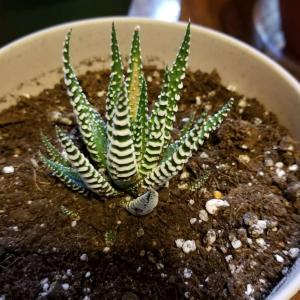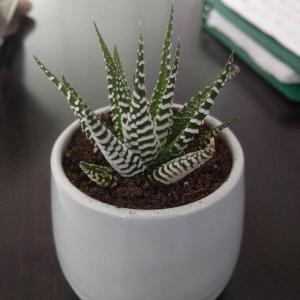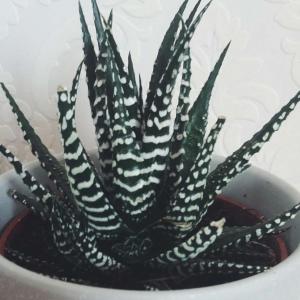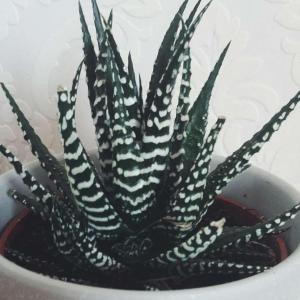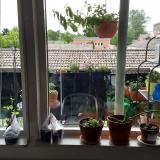文章
Dummer. ゛☀
2017年08月13日

Fat juicy leaves and translucent flesh are the hallmarks of Haworthia window plant. Not all Haworthia have the see-through leaves, but those that do are spectacular specimens of the genus. Learning how to grow Haworthia is relatively easy, as they are a low maintenance and hardy little plant. Caring for window plants is very much like caring for their cousins, the Aloes.
For a long time, Haworthia was thought to belong to the Aloe family, but its class was reassigned in the early 1800’s as a more thorough breakdown of plant genera was undertaken. Not all plants in the genera have the window pane leaves with their opaque fleshy leaves and rich green interiors; the majority of the plants in the genus are small succulents with a low growth habit and similar cultivation requirements.
Haworthia Window Plant
The tiny succulents are native to USDA zones 9 to 11. They come in many forms, but the varieties with see-through foliage are usually comprised of triangular thick pads with an interior like the inside of a green gumdrop. Some species have a white band along the edge of the leaf and others have red tips. Haworthia care, no matter the species, is easy and minimal. They are best used in containers as interior plants but you can bring them outdoors in summer. In fact, succulent window leaved plants lend their candy-like appearance to a host of container gardening possibilities. In certain light, you can get a glimpse of the interior of window plants — the luscious flesh that comprises these water storing succulents.
How to Grow Haworthia
If you’re lucky enough to live in the warm zones, plant your window-leaved plants outside in full sun where soil is gritty and well draining. For most gardeners, this species is limited to indoor growth. Choose a container that has excellent drainage and use a cactus mix or blend of half potting soil and half grit such as sand or perlite. The container should be shallow, as the root system on window leaved plants is not deep. Place the potted succulent in a bright area with some protection from the hottest rays of the day. Water weekly during the summer or once the top of the soil has dried out. In winter, suspend watering except once per month.
Caring for Window Leaved Plants
Haworthia has no notable pests or diseases. When soil is kept too moist, soil gnats are common. Fungal or rot issues also ensue in plants that are kept in high humidity areas, dimly lit rooms or overwatered. Overwatering is probably the biggest cause of failure to thrive with this easy to grow plant. Keep your plant where it is 70 to 90 F. (21-32 C.) for best growth. Fertilize once in fall and once in spring. Rarely, you may get one or two small white flowers if your Haworthia window plant is really happy. Repot every two to three years to keep the root system healthy and soil at its peak.
For a long time, Haworthia was thought to belong to the Aloe family, but its class was reassigned in the early 1800’s as a more thorough breakdown of plant genera was undertaken. Not all plants in the genera have the window pane leaves with their opaque fleshy leaves and rich green interiors; the majority of the plants in the genus are small succulents with a low growth habit and similar cultivation requirements.

Haworthia Window Plant
The tiny succulents are native to USDA zones 9 to 11. They come in many forms, but the varieties with see-through foliage are usually comprised of triangular thick pads with an interior like the inside of a green gumdrop. Some species have a white band along the edge of the leaf and others have red tips. Haworthia care, no matter the species, is easy and minimal. They are best used in containers as interior plants but you can bring them outdoors in summer. In fact, succulent window leaved plants lend their candy-like appearance to a host of container gardening possibilities. In certain light, you can get a glimpse of the interior of window plants — the luscious flesh that comprises these water storing succulents.

How to Grow Haworthia
If you’re lucky enough to live in the warm zones, plant your window-leaved plants outside in full sun where soil is gritty and well draining. For most gardeners, this species is limited to indoor growth. Choose a container that has excellent drainage and use a cactus mix or blend of half potting soil and half grit such as sand or perlite. The container should be shallow, as the root system on window leaved plants is not deep. Place the potted succulent in a bright area with some protection from the hottest rays of the day. Water weekly during the summer or once the top of the soil has dried out. In winter, suspend watering except once per month.

Caring for Window Leaved Plants
Haworthia has no notable pests or diseases. When soil is kept too moist, soil gnats are common. Fungal or rot issues also ensue in plants that are kept in high humidity areas, dimly lit rooms or overwatered. Overwatering is probably the biggest cause of failure to thrive with this easy to grow plant. Keep your plant where it is 70 to 90 F. (21-32 C.) for best growth. Fertilize once in fall and once in spring. Rarely, you may get one or two small white flowers if your Haworthia window plant is really happy. Repot every two to three years to keep the root system healthy and soil at its peak.
3
1
文章
Dummer. ゛☀
2017年08月04日

Haworthia are delightful little succulents that form very attractive and singular small houseplants. Generally easy to grow, the same best practices that yield healthy aloe and echeveria plants will also produce beautiful Haworthia.
In terms of appeal, these small, low growing plants form rosettes of fleshy green leaves that are generously covered with white, pearly warts or bands, giving them a distinctive appearance.
Just like other succulents, these plants appreciate bright light, adequate moisture in the summer, and relatively drier conditions in the winter. Don't overwater, but don’t also let them dry out too much.
Growing Conditions
Light: Bright light, but not direct sunlight. These grow in similar conditions to other succulents. White or yellow leaves usually signify too much sun.
Water: Water evenly and generously in the summer, letting the soil media dry out between waterings. In the winter, reduce watering to every other month. Never allow water to collect in the rosette.
Temperature: Warmer summers but cool in the winter (down to 50 degrees F).
Soil: Use a cactus mix or very fast-draining potting soil mixed with sand.
Fertilizer: Fertilize during the summer growing season with a cactus fertilizer. Don't feed during the winter.
Propagation
Haworthia can be propagated at repotting time using offsets from the mother plant.
When taking offsets, use a sharp knife or snippers and cut as close to the mother stem as possible to including as many roots as possible, then allow the offset to dry briefly before repotting it (similar to cuttings from other succulents). Pot the offsets in a small pot, using the same soil as the mother plant, put it a warm, bright spot, and make sure to adequately water.
Repotting
Haworthia are small (usually remaining between 3" and 5" in height) and relatively slow-growing. They are often grown in small clusters in wide, shallow dishes. Over time, clusters will naturally enlarge as the mother plant sends off small plantlets.
When the cluster has outgrown its dish, repot in the spring or early summer into a new wide and shallow dish with fresh potting soil. This is also the time to take offsets for propagation.
Varieties
There are about 80 species of Haworthia, but their classification can be complex. The main difference between the common species is the size of the leaves and the orientation of the white markings on the leaves. H. margaritifera has warty white projections on the leaves, while H. fasciata features horizontal white stripes and is sometimes called the zebra plant.
Some of the species, such as H. bolusii have "tufted" edges to the leaves, while H. attenuata features long, pointed green leaves. In general, the best advice is to buy the most attractive variety based on leaf form and markings—they all have similar cultural requirements.
Grower's Tips
Haworthia are not considered difficult houseplants to grow—if you can keep a pot of aloe alive on a windowsill, chances are you can do the same with a dish of Haworthia.
As with all succulents, the most dangerous situation is too much water—they should never be allowed to sit in water under any circumstances.
At the same time, these decorative little plants can be grown in interesting containers such as tea cups and even miniature baby shoes. If you're given a Haworthia in such a container, make sure the container had adequate drainage. If it doesn't, it might be a good idea to pop the plant out of its container and add a layer of gravel to the bottom to reduce the wicking action of the soil above.
Finally, look out for sunburned spots on your plants.
In terms of appeal, these small, low growing plants form rosettes of fleshy green leaves that are generously covered with white, pearly warts or bands, giving them a distinctive appearance.
Just like other succulents, these plants appreciate bright light, adequate moisture in the summer, and relatively drier conditions in the winter. Don't overwater, but don’t also let them dry out too much.

Growing Conditions
Light: Bright light, but not direct sunlight. These grow in similar conditions to other succulents. White or yellow leaves usually signify too much sun.
Water: Water evenly and generously in the summer, letting the soil media dry out between waterings. In the winter, reduce watering to every other month. Never allow water to collect in the rosette.
Temperature: Warmer summers but cool in the winter (down to 50 degrees F).
Soil: Use a cactus mix or very fast-draining potting soil mixed with sand.
Fertilizer: Fertilize during the summer growing season with a cactus fertilizer. Don't feed during the winter.
Propagation
Haworthia can be propagated at repotting time using offsets from the mother plant.
When taking offsets, use a sharp knife or snippers and cut as close to the mother stem as possible to including as many roots as possible, then allow the offset to dry briefly before repotting it (similar to cuttings from other succulents). Pot the offsets in a small pot, using the same soil as the mother plant, put it a warm, bright spot, and make sure to adequately water.
Repotting
Haworthia are small (usually remaining between 3" and 5" in height) and relatively slow-growing. They are often grown in small clusters in wide, shallow dishes. Over time, clusters will naturally enlarge as the mother plant sends off small plantlets.
When the cluster has outgrown its dish, repot in the spring or early summer into a new wide and shallow dish with fresh potting soil. This is also the time to take offsets for propagation.

Varieties
There are about 80 species of Haworthia, but their classification can be complex. The main difference between the common species is the size of the leaves and the orientation of the white markings on the leaves. H. margaritifera has warty white projections on the leaves, while H. fasciata features horizontal white stripes and is sometimes called the zebra plant.
Some of the species, such as H. bolusii have "tufted" edges to the leaves, while H. attenuata features long, pointed green leaves. In general, the best advice is to buy the most attractive variety based on leaf form and markings—they all have similar cultural requirements.

Grower's Tips
Haworthia are not considered difficult houseplants to grow—if you can keep a pot of aloe alive on a windowsill, chances are you can do the same with a dish of Haworthia.
As with all succulents, the most dangerous situation is too much water—they should never be allowed to sit in water under any circumstances.
At the same time, these decorative little plants can be grown in interesting containers such as tea cups and even miniature baby shoes. If you're given a Haworthia in such a container, make sure the container had adequate drainage. If it doesn't, it might be a good idea to pop the plant out of its container and add a layer of gravel to the bottom to reduce the wicking action of the soil above.
Finally, look out for sunburned spots on your plants.
2
6
文章
Colour_
2017年07月27日

水晶掌(Haworthia cymbiformis var.triebnet poelln),是百合科十二卷属的多肉植物,原产南非。植株矮小,株高一般5~6厘米。叶形叶色较美,有一定的观赏价值。
形态特征
植株矮小,株高一般5~6厘米。叶片互生,长圆形或匙状,肉质肥厚,生于极短的茎上,紧密排列为莲座状,叶色翠绿色,叶肉呈半透明状,叶面有8~12条暗褐色条纹或中间有褐色、青色的斑块,叶缘粉红色,有细锯齿。顶生总状花序,花极小。是常见的多肉植物之一。
水晶掌常为雌雄同株,花两性。花葶纤细,自叶簇中央的叶腋间抽生而出,大大超过叶簇。顶生总状花序,花极小,无观赏价值,开花后叶簇显得松散。
生长习性
喜温暖而湿润及半荫的环境,耐干旱,忌炎热,不耐寒,生长适温为20~25℃,要求肥沃、排水良好的沙质土壤。
繁殖方法
以分株法繁殖,每年3月开始长出侧芽,此时应换用大盆,生长条件不同侧芽数量差别很大,从4-9株不等,繁殖时把侧芽掰下来插入土中即可。
实践证明侧芽本身长出6-8片叶片后是分株的最佳时间,此时侧芽根较浅易于分离,且生存率显著提高。新上盆的植株浇水不要太多,以免引起腐烂,但需要保持湿润,等新根长出后才能正常浇水。
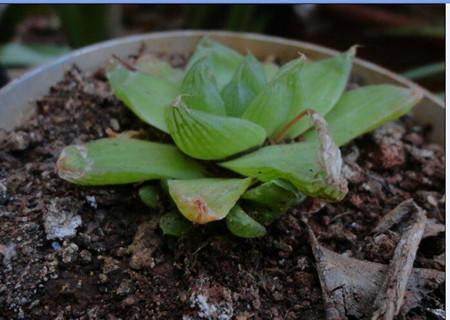
水晶掌为什么会烂根呢
水晶掌是肉质植物,本身比较耐干旱和高温,但是在浇水浇多了的情况下,是会出现烂根的,还可能导致叶片腐烂。
另外,出现烂根也有可能是土壤和施肥不当的缘故。因为水晶掌喜欢疏松肥沃的排水性良好的土壤,土壤的通透性差也很容易腐烂。施肥不当则主要是因为在施肥的时候不小心沾污了根部或者是叶子,导致出现烂根和叶片腐烂的现象。

水晶掌出现烂根要怎么办
水晶掌如果出现了烂根,首先要把已经烂掉的根部或者是化水的根部和叶子处理掉,可以将腐烂的部分切掉,然后将伤口晾干,重新上盆换土养殖。还有一种方法就是进行分株繁殖,在出现烂根的情况下,可以将水晶掌生长比较完好的侧芽取下来进行栽植即可。
不过,水晶掌的烂根问题,最根本的还是要做好预防,预防主要就是要合理的浇水。在平时的时候,浇水就不能太多,一般盆土不干不浇即可。但是有时候植株也会缺水,此时不需要浇太多的水,及时的补水并向植株喷水,在夏季高温的时候植株会进行半休眠的状态,除了要减少浇水,还需要加强通风,可以避免根部和嫩叶的腐烂,有时还需及时的将盆内的积水排掉。
形态特征
植株矮小,株高一般5~6厘米。叶片互生,长圆形或匙状,肉质肥厚,生于极短的茎上,紧密排列为莲座状,叶色翠绿色,叶肉呈半透明状,叶面有8~12条暗褐色条纹或中间有褐色、青色的斑块,叶缘粉红色,有细锯齿。顶生总状花序,花极小。是常见的多肉植物之一。
水晶掌常为雌雄同株,花两性。花葶纤细,自叶簇中央的叶腋间抽生而出,大大超过叶簇。顶生总状花序,花极小,无观赏价值,开花后叶簇显得松散。
生长习性
喜温暖而湿润及半荫的环境,耐干旱,忌炎热,不耐寒,生长适温为20~25℃,要求肥沃、排水良好的沙质土壤。
繁殖方法
以分株法繁殖,每年3月开始长出侧芽,此时应换用大盆,生长条件不同侧芽数量差别很大,从4-9株不等,繁殖时把侧芽掰下来插入土中即可。
实践证明侧芽本身长出6-8片叶片后是分株的最佳时间,此时侧芽根较浅易于分离,且生存率显著提高。新上盆的植株浇水不要太多,以免引起腐烂,但需要保持湿润,等新根长出后才能正常浇水。

水晶掌为什么会烂根呢
水晶掌是肉质植物,本身比较耐干旱和高温,但是在浇水浇多了的情况下,是会出现烂根的,还可能导致叶片腐烂。
另外,出现烂根也有可能是土壤和施肥不当的缘故。因为水晶掌喜欢疏松肥沃的排水性良好的土壤,土壤的通透性差也很容易腐烂。施肥不当则主要是因为在施肥的时候不小心沾污了根部或者是叶子,导致出现烂根和叶片腐烂的现象。

水晶掌出现烂根要怎么办
水晶掌如果出现了烂根,首先要把已经烂掉的根部或者是化水的根部和叶子处理掉,可以将腐烂的部分切掉,然后将伤口晾干,重新上盆换土养殖。还有一种方法就是进行分株繁殖,在出现烂根的情况下,可以将水晶掌生长比较完好的侧芽取下来进行栽植即可。
不过,水晶掌的烂根问题,最根本的还是要做好预防,预防主要就是要合理的浇水。在平时的时候,浇水就不能太多,一般盆土不干不浇即可。但是有时候植株也会缺水,此时不需要浇太多的水,及时的补水并向植株喷水,在夏季高温的时候植株会进行半休眠的状态,除了要减少浇水,还需要加强通风,可以避免根部和嫩叶的腐烂,有时还需及时的将盆内的积水排掉。
0
0
成长记
Mider
2017年07月24日

我新添加了一棵“Haworthia pygmaea var. pygmaea Select,very rough leaf No.2”到我的“花园”


0
0
成长记
Mider
2017年07月24日

我新添加了一棵“Haworthia pygmaea var. pygmaea Select,very rough leaf No.1”到我的“花园”


0
0



